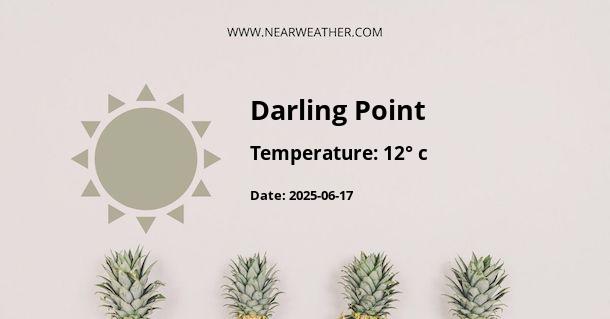Darling Point, AU: A Guide to Its Climate and Weather Year Round
Darling Point, located in the eastern suburbs of Sydney, Australia, is a beautiful and picturesque neighborhood known for its stunning views of Sydney Harbour and its affluent residential area. If you are planning a visit or considering moving to Darling Point, it is important to understand the climate and weather patterns of the area. In this guide, we will explore Darling Point's climate and weather conditions throughout the year, providing you with valuable information to help you plan your activities and make the most of your time in this charming neighborhood.
Seasonal Overview
Darling Point experiences a temperate climate, characterized by mild winters and warm summers. The area benefits from the moderating influence of the nearby ocean, which helps to keep temperatures relatively stable throughout the year.
Let's take a closer look at each season in Darling Point:
1. Spring (September to November)
Spring in Darling Point is a delightful time to visit, with mild temperatures and an abundance of blooming flowers. The average temperature ranges from 15°C (59°F) to 22°C (72°F). It is advisable to pack light layers and a light jacket to accommodate for cooler evenings.
The spring season also sees an increase in rainfall, with an average of 80-100mm (3-4 inches) per month. It is a good idea to carry an umbrella or raincoat during this time.
2. Summer (December to February)
Summer in Darling Point is warm and sunny, with average temperatures ranging from 20°C (68°F) to 27°C (81°F). This is the peak tourist season, as visitors flock to enjoy the stunning harbor views and nearby beaches.
Rainfall during the summer months is relatively low, with an average of 60-70mm (2-3 inches) per month. However, occasional thunderstorms can occur, so it is advisable to check the weather forecast and be prepared for sudden showers.
3. Autumn (March to May)
Autumn in Darling Point is mild and comfortable, with temperatures ranging from 16°C (61°F) to 22°C (72°F). The weather is generally sunny with lower humidity levels compared to summer.
Rainfall during autumn is similar to spring, with an average of 80-100mm (3-4 inches) per month. It is a great time to explore the neighborhood and enjoy outdoor activities.
4. Winter (June to August)
Winter in Darling Point is relatively mild compared to many other parts of the world. Average temperatures range from 10°C (50°F) to 16°C (61°F). While it can occasionally get chilly, frost and snow are extremely rare in this area.
Rainfall during winter is lower compared to spring and autumn, with an average of 60-70mm (2-3 inches) per month. It is advisable to pack a jacket and warm clothing to stay comfortable during cooler evenings.
Climate Data
To provide a more comprehensive understanding of Darling Point's climate, let's take a look at some climate data:
| Month | Average High (°C) | Average Low (°C) | Average Rainfall (mm) |
|---|---|---|---|
| January | 26 | 19 | 77 |
| February | 26 | 19 | 78 |
| March | 25 | 18 | 100 |
| April | 23 | 15 | 82 |
| May | 20 | 12 | 92 |
| June | 17 | 9 | 79 |
| July | 17 | 8 | 68 |
| August | 18 | 9 | 62 |
| September | 21 | 11 | 62 |
| October | 23 | 14 | 65 |
| November | 24 | 16 | 76 |
| December | 25 | 18 | 74 |
Source: Bureau of Meteorology, Australia
As evident from the data, temperatures in Darling Point range from an average high of 26°C (79°F) in January and February to an average low of 9°C (48°F) in June and July. The area experiences a moderate amount of rainfall throughout the year, with the highest average rainfall occurring in March.
Additional Climate Considerations
When planning your visit to Darling Point, it is essential to consider a few additional climate-related factors:
1. UV Index
Australia has one of the highest UV indexes in the world, with increased risk of sunburn and skin damage. It is important to wear sunscreen, a hat, and sunglasses, and seek shade during the peak hours of the day, especially in summer.
2. Bushfire Risk
During the hotter months, there is a potential risk of bushfires in some parts of Australia, including Darling Point. It is advisable to stay informed about any fire warnings and follow the guidance of local authorities.
3. Water Activities
Given the proximity to Sydney Harbour, water activities such as swimming, boating, and sailing are popular in Darling Point. It is important to check the local tide and weather conditions before engaging in any water-based activities.
Conclusion
Darling Point, AU, offers a pleasant and temperate climate year-round, making it an ideal destination for outdoor activities and enjoying its natural beauty. Whether you visit in the spring when the flowers are in bloom, during the warm and sunny summer months, in the mild and comfortable autumn, or even during the relatively mild winters, Darling Point is sure to charm you with its stunning views and delightful climate.
Remember to pack accordingly for the season, and keep in mind the additional climate considerations to ensure a safe and enjoyable time in this picturesque neighborhood.
A - Darling Point's Latitude is -33.870831 & Longitude is 151.238892.
A - Weather in Darling Point is 23° today.
A - Climate Conditions in Darling Point shows light rain today.
A - Humidity in Darling Point is 79% today.
A - Wind speed in Darling Point is 37.04 km/h, flowing at 170° wind direction. today.
